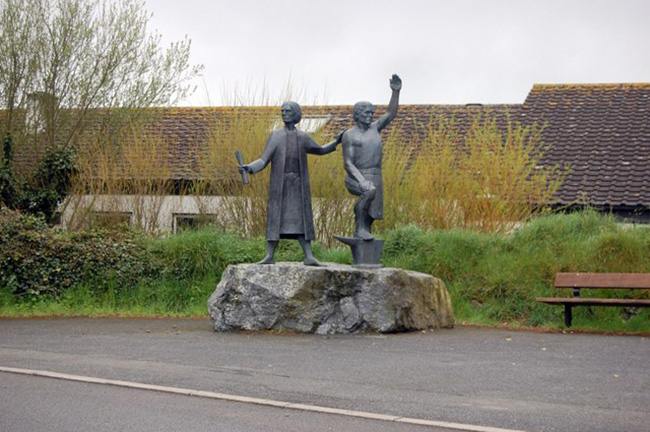
Although most agree that the Wars of the Roses culminated with the decisive Lancastrian victory near Bosworth on 22 August 1485, for the newly-crowned King Henry VII this was far from the end to the instability that had shaken England for the past forty years. The threat lingered – epitomised by the rise of the pretender Perkin Warbeck.
Here are twelve facts about this pretender to the English throne:
1. He was the second of two pretenders in Henry VII’s reign
Henry VII had already been challenged by a previous pretender in 1487: Lambert Simnel, who claimed to be Edward Plantagenet.
Although he rallied some Yorkist support, Simnel’s forces were defeated at the Battle of Stoke Field on 16 June 1487. Some consider this battle, and not Bosworth, to be the final battle of the Wars of the Roses.
 Watch Now
Watch NowHenry pardoned Simnel but kept his former enemy close, employing him as a scullion in the royal kitchens. Later, Simnel progressed to become a royal falconer.
2. Warbeck claimed to be Richard, Duke of York
Richard was one of the nephews of Richard III and one of the two ‘Princes in the Tower’ who had mysteriously disappeared during the previous decade.
Richard was also the sister of Elizabeth of York, the wife of Henry VII.
3. His main supporter was Margaret, Duchess of Burgundy
Margaret was the sister of the late Edward IV and supported Warbeck’s claim to be Richard Duke of York, her nephew.
She ensured the young pretender was well-versed in Yorkist family history and funded a small professional army, along with the necessary transport ships, to ferry Warbeck’s force across the Channel to England.
 Listen Now
Listen Now4. Warbeck’s army attempted to land in England on 3 July 1495…
Supported by 1,500 men – many of whom were battle-hardened continental mercenaries – Warbeck had chosen to land his army at the port town of Deal in Kent.
5. …but they were met with fierce opposition.
Local Tudor supporters violently opposed the invasion force’s landing at Deal. A battle ensued on the beach and eventually Warbeck’s army was forced to withdraw and abandon the amphibious assault.
It is the only time in history – aside from Julius Caesar’s first visit to Britain – that an English force has opposed an invading army on the beaches.
6. He then sought support in Scotland
After a disastrous campaign in Ireland, Warbeck fled to Scotland to seek aid from King James IV. James agreed and gathered a significant, modern army to invade England.
The invasion proved disastrous: support in Northumberland failed to materialise, the army’s logistics were woefully underprepared and a stronger English army stood ready to oppose them.
Soon after James made peace with England and Warbeck returned to Ireland, disgraced and no better off.
7. Warbeck cast his die one last time in Cornwall
On 7 September 1497 Perkin Warbeck and his 120 men landed at Whitesand Bay near Lands End.
His arrival in Cornwall was well-timed: a popular uprising against Henry had occurred in the region barely 3 months earlier.
The uprising was brutally suppressed by the sword on the outskirts of London at the Battle of Deptford Bridge. Warbeck was hoping to capitalise on lingering Cornish resentment in its aftermath.

Statue of Michael Joseph the Smith and Thomas Flamank On the road out of St Keverne, this statue commemorates these two leaders of the Cornish Rebellion of 1497. They led a Cornish host to London, where they were put to death. Credit: Trevor Harris / Commons.
8. His hopes came to fruition…
Cornish resentment remained high and some 6,000 men joined the young pretender’s cause, declaring him King Richard IV.
At the head of this army, Warbeck started marching towards London.
9. …but Warbeck was no warlord
When Warbeck heard that a royal army was marching to confront his Cornish army, the young pretender panicked, deserting his army and fleeing to Beaulieu Abbey in Hampshire.
Warbeck’s sanctuary was surrounded, the young pretender surrendered (as did his Cornish army) and was paraded as a prisoner through the streets of London to the Tower.
10. Warbeck soon confessed to being an imposter
As soon as Warbeck confessed, Henry VII released him from the Tower of London. It seemed he was destined for a fate similar to that of Lambert Simnel – treated well in the Royal Court, but always remaining under Henry’s eye.
11. He twice tried to escape
Both attempts came in 1499: he was quickly captured after escaping Henry’s court the first time and Henry had him placed, once again, in the tower.
There he and another prisoner, Edward Plantagenet, devised a second escape attempt, but the plan was uncovered and foiled before it came to fruition.
12. Perkin Warbeck was executed on 23 November 1499
He was lead from the Tower to Tyburn Tree, where he confessed and was hanged. The last great threat to Henry VII’s rule had been extinguished.














